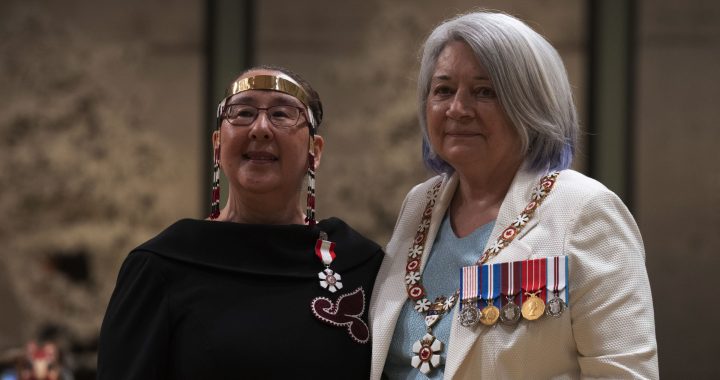Bundles of dried sage tied together with red ribbon hang from black fixtures connected to wood-panelled walls.
The space in a building known simply as “the lodge” may be small, but it is mighty in meaning.
Outside, nearly two dozen colourful apartment units form a circle. A sacred fire sits bull’s-eye.
It’s Winnipeg’s first tiny home village for people experiencing a lack of safe accommodation, dubbed Astum Api Niikinaahk or “come sit at our home” in Michif.
After years of development, the first residents moved in last month.
Tears filled Melissa Stone’s eyes when she handed the first tenant a key.
“He got into his robe and fell asleep? he was just happy and in tears. The smile, it was just beautiful,” she said.
Stone is the coordinator at Astum Api Niikinaahk, which is overseen by Ma Mawi Wi Chi Itata Centre, a community service provider. Planning for the project started in late 2019 after consultations with people who have first-hand experience with homelessness.
“It had to be something that they could call their home. They didn’t want to worry about being kicked out if they smoked a cigarette in their room,” said Stone.
There are 22 bachelor-style units, four accessible for people who use wheelchairs or walkers. Each suite has a bathroom, bed, television, and a kitchenette with a sink, microwave, stove and mini-fridge.
Designs originally included stained glass windows and skylights, but practicality prevailed.
“It was those esthetic things that we thought would make it brighter and more beautiful, but that wasn’t reality to someone who’s been living on the streets for years,” said Stone, adding some residents may have been concerned about someone breaking the glass.
“Safety’s number 1.”
Rounding out the village is “the lodge,” which houses staff offices, a commercial kitchen, a programming area, medical clinic and the traditional medicine room. Organizers hope to include a 10-person sweat lodge for ceremonies.
Staff provides mental health, addiction, medical and cultural services.
Giving individuals a place to settle and stabilize allows them a chance to “reconnect to their culture and their own journey,” instead of constantly searching for heat and food, said Stone.
Rochelle Drury, the harm reduction planner at the village, says team members meet residents where they’re at.
“We’re offering those tools to change. Inviting them in and making them feel safe with taking (the help),” said Drury.
For some residents, transitioning into their own homes can present challenges after years on the streets.
“Even if it’s small steps for people, we’re going to be able to help them through those,” said Drury.
Referrals can be made by individuals or the project’s partner agencies. Rental rates vary depending on how residents receive their income. There is no limit to how long people can live there, said Stone.
“Everyone heals differently, so they can stay as long as they need.”
The project received funding for construction from the federal government’s Rapid Housing Initiative in 2020. It was originally supposed to open the following summer but was delayed due to the COVID-19 pandemic and the rising costs of building materials.
While tiny house villages have long been called for by advocacy groups to address homelessness, few have been set up across the country. Some are operating in Edmonton and Calgary for veterans. The federal government has provided funding for projects in Saskatchewan and Yukon.
Operational costs work out to between $800,000 to $900,000 a year, says Stone, and will be covered by some of their partners, the province and United Way. However, permanent funding has not been secured.
Jason Whitford, CEO of End Homelessness Winnipeg, would like to see municipal budgets address the need. The organization is one of the partners for the village project.
Whitford estimates the city needs about 1,800 units to address the homeless crisis, with about one-third being transitional housing to respond to complex challenges people living with mental health problems, addictions or trauma may experience.
“There’s a tremendous demand for culturally appropriate housing in our city to respond to chronic homelessness, particularly Indigenous-led solutions,” he said.
Data collected last year during the Winnipeg Street Census suggests about three-quarters of those experiencing homelessness are Indigenous.
The city has seen recent examples of first responders being called to encampments for fires or overdoses while one woman was found dead in a bus shelter.
Without upfront funding for social housing, Whitford said, “we’re not going to be ending homelessness, we’re going to be managing it.”










